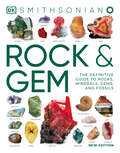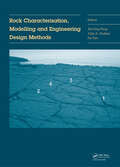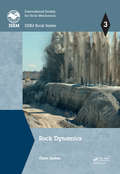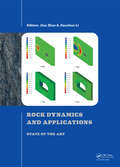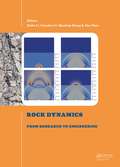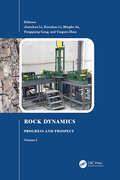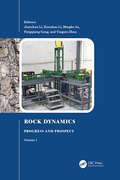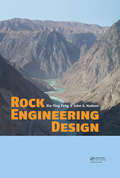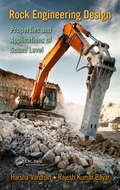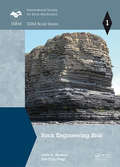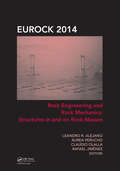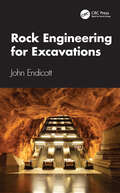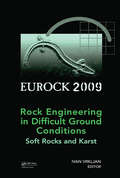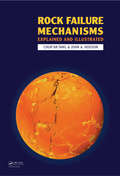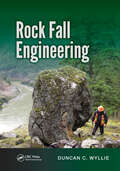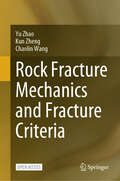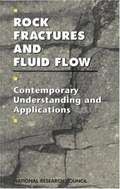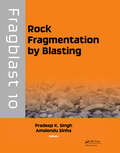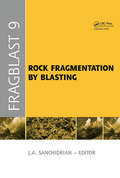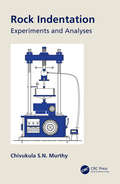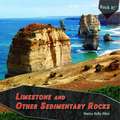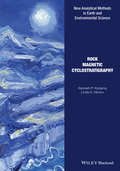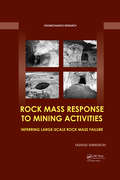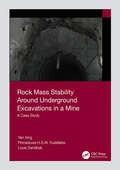- Table View
- List View
Rock & Gem
by DKYour compact guide to more than 450 rocks, crystals, gemstones, and fossilsExplore the treasures of the Earth—sparkling crystals, vibrant gemstones, and age-old fossils—with this illustrated guide that's sure to captivate every rockhound and budding gemmologist.From primeval origins to their astonishing modern-day uses and appeal, this is the ultimate portrait of Earth's geological riches. Also included is a focused look at other precious materials often prized for their beauty, such as amber, coral, ivory, and fossils.Learn how to identify more than 450 rock and gem specimens through stunning photographs and detailed characteristics. Discover more about rocks and gems through folklore and historical artifacts and find out the fascinating stories behind some of the amazing natural treasures, including the Hope Diamond and the Great Mogul emerald. It also contains information on polishing and displaying your finds to further equip you with all the knowledge needed to delve into the arena of rock and mineral collecting.Rocks & Gems was produced in association with the Smithsonian in Washington, D.C., the world's largest museum complex, ensuring the guide's accuracy.
Rock Characterisation, Modelling and Engineering Design Methods
by John A. Hudson Xia-Ting Feng Fei TanRock Characterisation, Modelling and Engineering Design Methods contains the contributions presented at the 3rd ISRM SINOROCK Symposium (Shanghai, China, 18�20 June 2013). The papers contribute to the further development of the overall rock engineering design process through the sequential linkage of the three themes of rock characterisation, model
Rock Dynamics (ISRM Book Series)
by Omer AydanRock dynamics has become one of the most important topics in the field of rock mechanics and rock engineering. The spectrum of rock dynamics is very wide and it includes the failure of rocks, rock masses and rock engineering structures such as rockbursting, spalling, popping, collapse, toppling, sliding, blasting, non-destructive testing, geophysical explorations, science and engineering of rocks and impacts. The book specifically covers fundamentals of rock dynamics, constitutive models, numerical analysis techniques, dynamic testing procedures, the multi-parameter responses and motions of rocks during fracturing or slippage in laboratory experiments, earthquakes and their strong motion characteristics and their effect on various rock structures such as foundations, underground structures, slopes, dynamic simulation of loading and excavation, blasting and its positive utilization in rock engineering, the phenomenon of rockburst in rock excavations, non-destructive testing of rockbolts and rock anchors and impacts by meteors or projectiles. The main goal of this book is to present a unified and complete treatise on Rock Dynamics and to represent a milestone in advancing the knowledge in this field and in leading to new techniques for experiments, analytical and numerical modelling as well as monitoring of dynamics of rocks and rock engineering structures.
Rock Dynamics and Applications - State of the Art
by Jian Zhao Jianchun LiRock dynamics studies the response of rock materials and rock masses under dynamic loading conditions. In the last a couple of decades, the development of experimental and computational techniques has been able to capture the progress of fracturing in microsecond steps, allowing the exploration on how the fracture is initiated, propagated and branc
Rock Dynamics: Proceedings of the 2nd International Conference on Rock Dynamics and Applications
by Jian Zhao Haibo Li Jianchun Li Qianbing ZhangRock Dynamics: From Research to Engineering is a collection of the scientic and technical papers presented at the Second International Conference on Rock Dynamics and Applications (RocDyn-2, Suzhou, China, 18-19 May 2016). The book has four sections. The first section contains 8 keynote papers, covering a wide range of dynamic issues related to roc
Rock Dynamics: Proceedings of the Fourth International Conference on Rock Dynamics And Applications (RocDyn-4, 17–19 August 2022, Xuzhou, China)
by Jianchun LiRock Dynamics: Progress and Prospect contains 153 scientific and technical papers presented at the Fourth International Conference on Rock Dynamics and Applications (RocDyn-4, Xuzhou, China, 17-19 August 2022). The two-volume set has 7 sections. Volume 1 includes the first four sections with 6 keynotes and 5 young scholar plenary session papers, and contributions on analysis and theoretical development, and experimental testing and techniques. Volume 2 contains the remaining three sections with 74 papers on numerical modelling and methods, seismic and earthquake engineering, and rock excavation and engineering. Rock Dynamics: Progress and Prospect will serve as a reference on developments in rock dynamics scientific research and on rock dynamics engineering applications. The previous volumes in this series (RocDyn-1, RocDyn-2, and RocDyn-3) are also available via CRC Press.
Rock Dynamics: Proceedings of the Fourth International Conference on Rock Dynamics And Applications (RocDyn-4, 17–19 August 2022, Xuzhou, China)
by Jianchun LiRock Dynamics: Progress and Prospect contains 153 scientific and technical papers presented at the Fourth International Conference on Rock Dynamics and Applications (RocDyn-4, Xuzhou, China, 17-19 August 2022). The two-volume set has 7 sections. Volume 1 includes the first four sections with 6 keynotes and 5 young scholar plenary session papers, and contributions on analysis and theoretical development, and experimental testing and techniques. Volume 2 contains the remaining three sections with 74 papers on numerical modelling and methods, seismic and earthquake engineering, and rock excavation and engineering. Rock Dynamics: Progress and Prospect will serve as a reference on developments in rock dynamics scientific research and on rock dynamics engineering applications. The previous volumes in this series (RocDyn-1, RocDyn-2, and RocDyn-3) are also available via CRC Press.
Rock Engineering Design
by John A. Hudson Xia-Ting FengGiven the recent advances in site investigation techniques, computing, access to information and monitoring, plus the current emphasis on safety, accountability and sustainability, this book introduces an up-to-date methodology for the design of all types of rock engineering projects, whether surface or underground. Guidance is provided on the natu
Rock Engineering Design: Properties and Applications of Sound Level
by Harsha Vardhan Rajesh Kumar BayarPhysico-mechanical rock properties are significant in all operational mining activities. This book evaluates rock properties by using empirical equations and soft computing techniques. It predicts various physico-mechanical properties such as uniaxial compressive strength (UCS), Schmidt rebound number (SRN), dry density, P-wave velocity (Vp), tensile strength (TS), Young's modulus (E), and percentage porosity (n) using multiple regression and artificial neural network (MLP and RBF) techniques, taking drill bit speed, penetration rate, drill bit diameter, and equivalent sound level produced during drilling as input parameters.
Rock Engineering Risk (ISRM Book Series)
by Xia-Ting Feng John A. HudsonThis book provides a new, necessary and valuable approach to the consideration of risk in underground engineering projects constructed within rock masses. There are Chapters on uncertainty and risk, rock engineering systems, rock fractures and rock stress, the design of a repository for radioactive waste, plus two major case examples relating to th
Rock Engineering and Rock Mechanics: Structures in and on Rock Masses
by Áurea Perucho Rafael Jiménez Claudio Olalla Leandro R. AlejanoRock Engineering and Rock Mechanics: Structures in and on Rock Masses covers the most important topics and state-of-the-art in the area of rock mechanics, with an emphasis on structures in and on rock masses. The 255 contributions (including 6 keynote lectures) from the 2014 ISRM European Rock Mechanics Symposium (EUROCK 2014, Vigo, Spain, 27-29 Ma
Rock Engineering for Excavations
by John EndicottThis book provides an introduction to the whole engineering process of designing and constructing deep excavations in rock, including caverns, tunnels, shafts, and pits.The process is comprehensively covered from initial site planning, through design considerations such as the assessment of rock mass properties, the closure of contracts and resolution of disputes, and lastly onto the maintenance and final decommissioning or repurposing of underground facilities. The subject material is derived from the author’s extensive practice, with reference to successful projects and cases where things went wrong.Written accessibly and starting from the basics, Rock Engineering for Excavations serves as a comprehensive and practical guide for undergraduate and master’s students, as well as non-specialist project managers.
Rock Engineering in Difficult Ground Conditions - Soft Rocks and Karst
by Ivan VrkljanContaining 129 papers in geological and hydrogeological properties of karst regions, rock properties, testing methods and site characterization, design methods and analyses, monitoring and back analysis, excavation and support, environmental aspects of geotechnical engineering in karst regions and case histories, this volume is of interest to professionals, engineers, and academics involved in rock mechanics and rock engineering.
Rock Failure Mechanisms: Illustrated and Explained
by John A. Hudson Chun'An TangWhen dealing with rock in civil engineering, mining engineering and other engineering, the process by which the rock fails under load should be understood, so that safe structures can be built on and in the rock. However, there are many ways for loading rock and rock can have a variety of idiosyncracies. This reference book provides engineers and r
Rock Fall Engineering
by Duncan C. WyllieRock falls can be a public safety issue. This book provides comprehensive information on identification of these hazards, and design and construction of protection methods.Rock Fall Engineering describes first, the theoretical background to rock fall behavior in terms of the impact and trajectory phases of rock falls, and second, how this informati
Rock Fracture Mechanics and Fracture Criteria
by Yu Zhao Kun Zheng Chaolin WangThis open access book delves into the realms of geotechnical engineering and solid mechanics. In order to establish fracture parameters that are both relevant and conducive to safety, the book extensively investigates the fracture mechanical properties of mode I, mode II, and mode III in brittle rock materials. Various fracture testing methods and fracture mechanics theories are employed for a comprehensive examination. To provide a theoretical interpretation of the fracture test results, the book presents detailed derivations of established fracture criteria. Additionally, new fracture criteria are introduced to enhance fracture prediction models. Targeted at graduate students, scientists, and engineers engaged in the study of rock fracture mechanics, hydraulic fracturing, and material mechanics, this book serves as a valuable resource.
Rock Fractures And Fluid Flow: Contemporary Understanding and Applications
by Committee on Fracture Characterization Fluid FlowScientific understanding of fluid flow in rock fractures--a process underlying contemporary earth science problems from the search for petroleum to the controversy over nuclear waste storage--has grown significantly in the past 20 years. This volume presents a comprehensive report on the state of the field, with an interdisciplinary viewpoint, case studies of fracture sites, illustrations, conclusions, and research recommendations.The book addresses these questions: How can fractures that are significant hydraulic conductors be identified, located, and characterized? How do flow and transport occur in fracture systems? How can changes in fracture systems be predicted and controlled?Among other topics, the committee provides a geomechanical understanding of fracture formation, reviews methods for detecting subsurface fractures, and looks at the use of hydraulic and tracer tests to investigate fluid flow. The volume examines the state of conceptual and mathematical modeling, and it provides a useful framework for understanding the complexity of fracture changes that occur during fluid pumping and other engineering practices.With a practical and multidisciplinary outlook, this volume will be welcomed by geologists, petroleum geologists, geoengineers, geophysicists, hydrologists, researchers, educators and students in these fields, and public officials involved in geological projects.
Rock Fractures in Geological Processes
by Agust GudmundssonRock fractures control many of Earth's dynamic processes, including plate-boundary development, tectonic earthquakes, volcanic eruptions, and fluid transport in the crust. An understanding of rock fractures is also essential for effective exploitation of natural resources such as ground water, geothermal water, and petroleum. This book combines results from fracture mechanics, materials science, rock mechanics, structural geology, hydrogeology, and fluid mechanics to explore and explain fracture processes and fluid transport in the crust. Basic concepts are developed from first principles and illustrated with worked examples linking models of geological processes to real field observations and measurements. Many additional examples and exercises are provided online, allowing readers to practise formulating and quantitative testing of models. Rock Fractures in Geological Processes is designed for courses at the advanced undergraduate and graduate level but also forms a vital resource for researchers and industry professionals concerned with fractures and fluid transport in the Earth's crust.
Rock Fragmentation by Blasting: Fragblast 10
by Pradeep K. Singh Amalendu SinhaRock Fragmentation by Blasting contains the papers presented at the 10th International Symposium on Rock Fragmentation by Blasting (New Delhi, India, 26-29 November 2012), and represents the most advanced forum on blasting science and technology. The contributions cover all major recent advancements in blasting and fragmentation, from realistic tre
Rock Fragmentation by Blasting: Proceedings of the 9th Int. Symp. on Rock Fragmentation by Blasting - Fragblast 9, Sept. 2009, Granada Spain
by José A. SanchidriánThis volume contains the papers presented at the 9th International Symposium on Rock Fragmentation by Blasting, held in Granada, Spain, 13-17 August 2009. A state-of-the-art collection of articles on developments in rock blasting and explosives engineering, with contributions on rock characterization, explosives and initiation systems, blast design and monitoring, fragmentation assessment, numerical modeling, vibrations from blasting, environmental and economical aspects of rock blasting, and more. Containing unique knowledge, case studies, ideas and insights, this volume is must-have literature for researchers and practitioners in the field of explosives and blasting.
Rock Indentation: Experiments and Analyses
by Chivukula S.N. MurthyThis book focusses on rock indentation and importance of specific drilling/cutting energy as a performance indicator for drilling/rock cutting. It aids in designing of drill bit and cutting pick, through performance evaluation for a given geometry. It further covers stress distribution along three axes in rock during load application, correlation of specific energy with properties of rocks and statistical modeling to generate mathematical equation to estimate the specific energy indentation, including performance prediction by artificial neural network modeling. Presented models can be used to assess the specific energy in rock indentation from the physic-mechanical properties of rocks. Presents synthesis of rock indentation experiments and analyses. Deals with statistical modeling to generate mathematical equations to estimate the specific energy indentation from the rock parameters/properties. Discusses how to find the performance of drill and cutting bits during drilling or cutting operations through indentation test. Covers numerical modeling to explain stress distribution in rock during rock indentation. Includes artificial neural network concepts used in field of rock mechanics. This book is aimed at researchers and graduate students in mining/geological engineering, mechanical engineering.
Rock It: Limestone and Other Sedimentary Rocks
by Nancy Kelly AllenDiscusses sedimentary rocks, how they are formed, their characteristics, and their uses.
Rock Magnetic Cyclostratigraphy (Analytical Methods in Earth and Environmental Science)
by Kenneth P. Kodama Linda A. HinnovRock magnetic cyclostratigraphy merges environmental magnetism, in which rock magnetic measurements are used to detect past environmental change, and cyclostratigraphy, in which cyclic variations of lithology or a sedimentary rock’s physical properties are related to astronomically-forced paleoclimate change. In addition to providing paleoclimate data, cyclostratigraphy can establish high-resolution chronostratigraphy for a sequence of sedimentary rocks, even at distant times in Earth’s history. This book provides an overview of concepts underlying these two techniques, recipes for the time series analysis of cyclostratigraphy, and case studies to illustrate the variety and breadth of problems addressed by rock magnetic cyclostratigraphy. New Analytical Methods in Earth and Environmental Science Because of the plethora of analytical techniques now available, and the acceleration of technological advance, many earth scientists find it difficult to know where to turn for reliable information on the latest tools at their disposal, and may lack the expertise to assess the relative strengths or limitations of a particular technique. This new series will address these difficulties by providing accessible introductions to important new techniques, lab and field protocols, suggestions for data handling and interpretation, and useful case studies. The series represents an invaluable and trusted source of information for researchers, advanced students and applied earth scientists wishing to familiarise themselves with emerging techniques in their field. All titles in this series are available in a variety of full-colour, searchable e-book formats.
Rock Mass Response to Mining Activities: Inferring Large-Scale Rock Mass Failure (Geomechanics Research)
by Tadeusz SzwedzickiMining activities may result in rock mass deterioration and instability that may lead to failure both in underground and open pit mines. Such deterioration represents a safety risk and may result in substantial financial losses. Rock mass response may lead to ground subsidence, fall of ground/caving, inundation, pillar collapse, seismic activities and slope and tailings dam instability. Each response is preceded by warning signs and precursors, which are identified in this book, with a view to providing guidelines for prediction and amelioration of damage to mining structures. Furthermore, case studies of both large scale ground deterioration leading to collapse and geotechnical mine disasters are presented. Identifying risks and monitoring geotechnical precursors and warning signs allows for safe and productive mining.
Rock Mass Stability Around Underground Excavations in a Mine: A Case Study
by Yan Xing Pinnaduwa H.S.W. Kulatilake Louis SandbakStability of underground excavations is of great importance to an operating mine because it ensures the safety of the working people and operating equipment, and successful ore production. Due to the complex geological conditions and mine constructions, and variability and uncertainty in estimating rock mass mechanical properties, the assessment of rock mass stability for an underground mine is extremely challenging and difficult. Tackling of this difficult problem is not covered in detail in any of the textbooks currently available in the rock mechanics literature. This monograph aims to cover this gap in the rock mechanics and rock engineering field. This monograph provides detailed procedures for the stability assessment and support design for an underground mine case study. It covers the background of the mine site including the monitored deformation data, the state-of-art methodologies for the stability analysis of rock masses around underground excavations, performed laboratory tests, estimation of the rock mass properties, a brief theory and background of the 3-D Distinct Element Code (3DEC), and numerical modeling of underground rock mass stability including investigation of the effectiveness of rock supports. The monograph is an excellent reference for the senior undergraduates, graduate students, researchers and practitioners who work in the Underground Rock Mechanics and Rock Engineering area in the Mining Engineering, Civil Geotechnical Engineering and DEM (Distinct Element Method) Numerical modeling.
